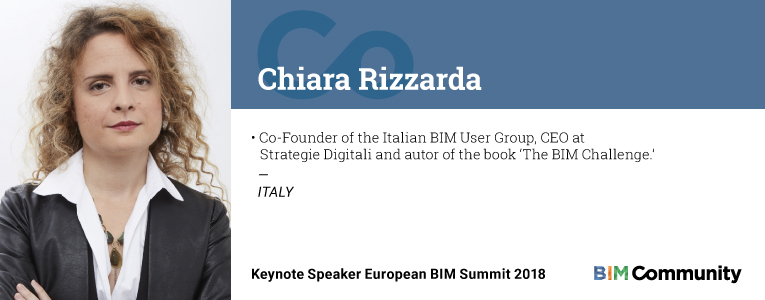Chiara C. Rizzarda: "Awareness plays a crucial part in the successful adoption of BIM"
She's an Autodesk certified instructor and the Co-Founder of Italian BIM user group

She’s Autodesk Certified Instructor, currently gives lectures and teaches Revit in norhern Italy, she sits at the table for the development of the Italian norm on BIM, she's co-founder of the Italian BIM User Group and is the proud co-creator of the one and only drinking game for BIM summits.
She recently founded her own Company, Strategie Digitali, with which she continues the work both in private and public consultancy, and she's a recurring speaker in the most important international BIM conventions.
BC: According to your experience in interior design, how BIM is reforming the workflows in this field? If there are which are the different principals than in an infrastructure work?
Interior Design, as defined by Italian architect and critic Bruno Zevi, is the study of the space in which «all manifestations of architecture are applied and conferred quality to». When it’s not reduced to refurbishment or decoration, it’s a completely autonomous discipline, with its own set of rules, components, tolerances and priorities. It relies upon complete coordination with the other disciplines and often works with systems of complex components. In its very nature, interior design needs information modelling to be adequately controlled, efficiently updated, seamlessly documented. We proud ourselves, as Italian, to be a leading Country when it comes to interior design and I had the honour of being BIM Project Coordinator for two masters of interior design in Italy: Piero Lissoni first and Antonio Citterio with Patricia Viel afterwards. I have seen first-hand how interior designer can benefit from the massive level of control and coordination provided by information modelling.
There are of course differences in how you model a complex interior and most digital instruments were conceived to deal with raw architecture or infrastructure: they require fine-tuning, which naturally is what you are expected to do as a digital strategist. I would say that the main difference lies in the fact that, as a discipline, interior often deals with minor variations, tailored solutions, matters of millimeters. There’s a high set of reasoning to be done upon what is going to be model ad what is going to be information, which are the appropriated model uses for the situation, but isn’t this valid for all disciplines, at the end of the day?
BC: When and why did you decide to initiate the Italian BIM User Group?
The input was actually given by my former BIM manager, current business partner, Claudio Vittori Antisari. He was returning in Italy after working abroad for a while and he had grown up in the very fertile environment of the University of Rome. He suggested we created a channel where BIM managers and professionals dealing with Virtual Design and Construction could meet and exchange opinions in a protected environment. Merging our visions vision and thanks to our local connections, we managed to have the first meeting in May 2016 and the group has grown exponentially ever since, both in terms of members and initiatives.
Along with a set of publications, we participated to the Digital & BIM fair in Bologna, last fall, with a non stop set of contributions throughout the whole two days. It is unprecedented, in Italy, for professionals working for different Firms to come together like that. A competitive environment is poisonous to collaboration and we are aiming to enhance our efforts in the future, alongside organizing Dynamo Meetups for Computational Designers.
BC: In 2016 you published ‘The BIM Challenge’, a three-part book on how to bring the BIM closer to design studios. What do you think is the critical element in order to achieve it?
Awareness plays a crucial part in the successful adoption of BIM and the process needs to be tailored to the core business, workflow and size of the firm: no action can be planned without a thorough understanding of the present situation. When the assessment has been carried out and the situation is clear, it needs to be stressed that an implementation plan needs to take into consideration all aspects of a practice: buying licenses of a BIM-enabling software and send your staff to a 40 hours course is far from being enough.
BC: The last ten/fifteen years great steps have been achieved in the way that people is using digital tools and processes. In the AEC sector which was/is the most challenging issue to be covered? Modelling, collaboration or the information management?
Norms, guidelines and standards are being published to facilitate their adoption, even though lots of gaps are still to be filled in the true legal implications of collaboration. The real struggle is a cultural, systemic one: the culture of data, of accuracy in both design and construction planning, the value of cooperation and collaboration have somehow been lost to our industry. We need to claim them back.
BC: Which would have to be according to your opinion three or more necessary elements for an AEC professional that is entering now the market?
Digital culture is necessarily the first. For a professional entering now the market is completely unacceptable to be lacking of the culture necessary to understand that AEC is a complex system and our job is based on a skillful use of the technology of our times. This is true in every segment of the industry and in every role. Skillfulness with the instruments of the job would be the third: the less you can offer in terms of field experience, the more you should offer in terms of up-to-date proficiency with cutting-edge tools. They can be information modelling software or data analysis systems, depending on your field of specialization, but they will be the first added value you can really offer to an employee having no experience.
The third thing should be the will to keep learning. Being out in the real world doesn’t mean that you can “finally stop studying”: quite the contrary. Our world is rapidly evolving and the great challenge stands in the ability to keep pace with this evolution.
The new public procurement plan defined a roadmap that will make BIM mandatory in a gradual way: we’ll start with projects over 100 million €, for which BIM will be mandatory in 2019, and we’ll grow from there: 50 millions in 2020, 15 millions in 2021, 5 millions in 2022, 1 million in 2023 and all works in 2025. It’s clearly a conservative roadmap, since lots of work still needs to be done in terms of infrastructure. Meanwhile, we see an increasing number of competitions and clients requiring BIM, although demands are not always clear.
To try and clear the fog, a technical norm is being written by UNI, the Italian ISO counterpart, and we have the honor of being part of the committee: the aim of this voluntary norm is to provide guidance and tools for information requirements, from LODs to naming conventions, from role definitions to an actual template for an Employer Information Requirements. The same group will also deal with the introduction of ISO 19650 (Organization of Information about Construction Works) when it will be made ready and sits at the CEN table to develop EU norms on BIM.
These are interesting times indeed. On one hand, we see big players rapidly evolving and adopting digital tools. On the other hand, lot of small entities are showing capabilities and skills that are enabling them to participate in important operations, and are growing fast. The majority of the market is however still struggling and, although awareness has dramatically increased over the past three years, I would argue that lots of professionals are still, struggling with the inevitability of the transformation.
BC: You will be participating in the upcoming European BIM Summit on this March as a speaker. Tell us some things about your participation. What could we expect from that?
BC: What about the one and only BIM Drinking game for Summits? Will there be a demonstration of it?












